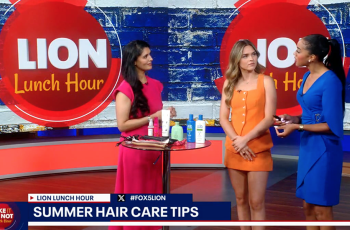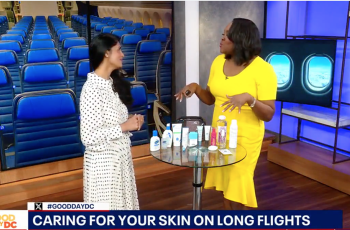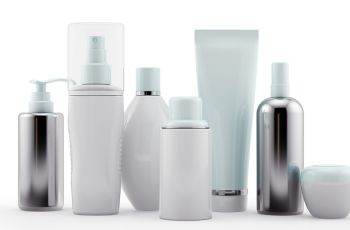During hot summer months, when it’s natural to spend more time outdoors, sun exposure – and resulting sunburns, skin damage, and possible skin cancers – can be painful and the effects long-lasting. Here, Pooja Sodha, MD, director of the Center for Laser and Cosmetic Dermatology at the George Washington University (GW) Medical Faculty Associates, explains the ins and outs of the sun’s effect on your skin and what you can do to stay healthy.
Q. What kind of skin damage can the sun or tanning beds cause?
Sodha: Sunlight is the main source of UV radiation (longer UV-A and shorter UV-B rays), the intensity of which is the greatest during the mid-day, in the summer, at high altitudes, and near the equator. Tanning beds use lamps that emit both UV-A and UV-B radiation. All skin types may develop changes with exposure to the sun and tanning beds. These UV rays penetrate the top layers of the skin and trigger damage that leads to fine lines; deep wrinkles; brown spots; broken capillaries; thick or leathery texture; or thin, sensitive skin.
Chronic sun damage may lead to an increased risk of skin cancer, such as squamous cell cancers, basal cell cancers, and melanoma. Sunburns increase the risk of cutaneous melanoma regardless of your age. Tanning bed exposure prior to the age of 18 increases your risk of melanoma by 85%.
Q. What can you do to protect your skin?
Sodha: Sun protection is the key, and this starts in childhood, because cellular damage is cumulative. Even one blistering sunburn in childhood potentially doubles the risk of developing melanoma later in life. When selecting a sunscreen, look for the label “Broad Spectrum” as this provides protection against both UV-A and UV-B rays. Water resistance is helpful if engaging in sports, but realize that this is effective for 40–80 minutes. So, we recommend reapplication of sunscreen every one-and-a-half to two hours. Seek out shade when you can, and utilize the protective features of hats, sunglasses, and sun-protective clothing (ultraviolet protection factor, or UPF, of greater than 40 means there is less than 2.5% UV transmission through the clothing).
Q. What should you look for when choosing a sunscreen?
Sodha: SPF denotes the sun protection factor and describes how much of the sun’s rays are blocked, specifically UV-B. I recommend a minimum SPF 30, which blocks 97% of UV-B rays. In 2011, the FDA mandated companies to label sunscreens as “Broad Spectrum” if they had also tested the products to ensure the same degree of UV-A blocking capacity. Since UV-A rays increase the damaging effects of UV-B rays, this dual protection is vitally important. For this reason, you should look for the “Broad Spectrum” label.
While SPF 15 has been shown to be effective in reducing the risk of skin cancer and signs of early aging, many of us do not apply enough sunscreen, which is why I recommend the higher SPFs. I favor mineral cream or stick sunscreens with zinc oxide, with or without titanium dioxide, as the main active ingredient. There is also the option of organic sunscreens, containing ingredients such as avobenzone, octinoxate, and oxybenzone, which have the benefit of being lightweight and easier to blend. Both offer their own advantages, and the key is to find the product you prefer and will use consistently. Remember that during extended sun exposure, the active ingredients in the sunscreen break down, so you should plan to reapply based on the times mentioned above.
Q. How can you protect different age groups, such as children and seniors, from sun-related skin problems?
Sodha: We do not recommend the use of sunscreen in children less than 6 months of age due to skin fragility, which may increase the risk of irritation or allergic reactions. It is best to avoid unnecessary sun exposure from 10 a.m. to 4 p.m. Wide-brimmed hats are effective in protecting the head, face, ears, and neck, and regular use will help to inculcate good habits for life if started in infancy. Sun-protective clothing can be very helpful until children are 6 months of age, at which time they will tolerate sunscreen in their regimen. Since young children and the elderly may have more sensitive skin, apply test areas prior to full application. And don’t forget eye protection! Damage from UV exposure starts in childhood when more time is spent outdoors and the immature lens is not as effective at filtering out UV rays.
Q. How should you treat sun-related skin problems, such as sunburns?
Sodha: Terminate sun exposure as soon as the sunburn is identified, and protect from further sun exposure until the area has healed. Cold compresses and showers can relieve some discomfort, along with generous emollients such as Vaseline or Aquaphor until the irritation is resolved. If there are particularly sensitive areas, speak with your dermatologist as a topical steroid may help to improve symptoms.
Oral anti-inflammatories such as acetaminophen or ibuprofen will help with the swelling and tenderness. If there is a large area of involvement, be sure to stay hydrated as compromised skin will need this nutritional support. Avoid picking or peeling your skin as it heals. Finally, be sure to share your history of sunburns with your dermatologist, so she or he may look at these areas carefully during your annual skin checks. Sunburned skin is at increased risk of issues down the road if not protected and monitored vigilantly.
Q. What skin changes should you keep an eye out for during the summer months, when your exposure to the sun is greater?
Sodha: It takes as little as 15 minutes to trigger skin changes from UV exposure. UV indices are typically the greatest during the summer months and during the mid-day as the sun’s rays are more direct, but you can get sunburned any time of the year. Even on overcast days, you are still at risk of getting burned since 80% of UV rays can penetrate the cloud cover. Signs such as increasingly tanned skin or darkening brown spots will help you recognize if your sun exposures are not protected adequately. You can track the local UV index using your phone weather app or with the U.S. EPA UV Index database, which allows you to search by zip code and track by hour.
Q. Any other tips for people to be aware of during the summer?
- Don’t forget the lips (SPF lip balm is very useful here) and eyes (with dual UV-A and UV-B protection, wrapping to the sides of the eyes).
- You need approximately 1 ounce of sunscreen (approximately 1 shot glass) for the entire body (about 6 teaspoons). One-half teaspoon should be reserved for the face. If using a spray sunscreen, hold the nozzle close to the skin and spray generously, followed by rubbing thoroughly. Avoid using a spray sunscreen outdoors when windy as there is a risk of inhalation and inadequate application.
- Vitamin D is produced in the skin with the aid of sun exposure, and its benefits span bone health, cancer prevention, heart health, and mood maintenance. But we often overestimate the amount of exposure needed to produce the necessary daily amount for the body. For a fair-skinned individual, this is no more than 15 minutes. Given the risks posed by unprotected sun exposure, it’s best to use sunscreen on all sun-exposed areas and strive to incorporate vitamin D-fortified foods to your diet to provide the necessary vitamin D (milk, cereal, orange juice). Speak to your doctor if you want to know if vitamin D supplementation is appropriate for you.
- Sunscreen is encouraged for ALL skin types. Though melanin, our natural pigment, is sun protecting, UV radiation has damaging effects the longer the exposure, no matter what skin type you have. Though darker skin types, like myself, may initially struggle to find the right shade and brand of sunscreen that works with our tone, I encourage you to sample a few products to find what works best. The investment is well worth it.
- Recently, Valisure, a virtual pharmacy, detected a human carcinogen, benzene, in 78 sunscreen/sun-related products. What is important to note is that we still do not understand the relevance of these findings because the cancer-causing effects are due to inhalation or ingestion. Moreover, there are numerous sunscreens that did not contain this contaminant. We want all of our patients to find a product with which they are comfortable and continue to use daily for all the important reasons mentioned above. If you have concerns about benzene in sunscreen, a list of sunscreens in which benzene was not found is available.


